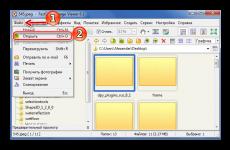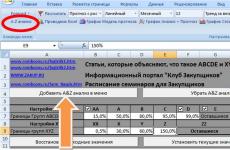Classification of fire extinguishers. Types of fire extinguishers: gas, foam, powder
Fire assessment
Option number 1
Completed: Art. gr IE-122
Abramov V.P.
Checked: Ph.D. Associate Professor Lezhava S.A.
Novokuznetsk 2014
Theoretical part.
Fires and their types.
Types of fires:
§ individual,
§ mass,
§ solid,
§ fire storm,
§ forest, steppe,
§ peat,
§ smoldering,
§ burning in rubble.
Separate fires arise in separate buildings dispersed throughout the area with a low building density (less than 15-20%), it is possible to withdraw victims through the fire area. Separate fires can be effectively extinguished in the first 10 - 20 minutes after the appearance of a fire.
continuous fires cover a significant area (more than 90%) with a building density of more than 20 - 30%. passage through the fire area is excluded. Rescue and other emergency work can be carried out 4-10 hours after the start of such fires. The main task is to localize the area of continuous fires.
massive fires- the totality of all types of fires.
Solid fires can turn into fire storm with continuous urban development, the absence of surface wind and low humidity, with their simultaneous occurrence in several places. In this case, a powerful flame column is formed, which is formed by air currents at a speed of 50 km / h, moving towards the center of the burning area. It is impossible to extinguish a firestorm, you can enter the fire area after 2 days. In new urban areas built up with buildings of 1 and 2 degrees of fire resistance, the occurrence of fire storms is practically excluded.
Types of fire extinguishers and their action.
There are manual fire extinguishers (up to 10 liters) and mobile (over 25 liters). Depending on the type of extinguishing agent contained in fire extinguishers, they are divided into liquid, carbon dioxide, chemical foam, air-foam, freon, powder And combined. Liquid fire extinguishers are filled with water with additives, carbon dioxide with liquefied carbon dioxide, chemical foam solutions of acids and alkalis, freon - with freons (for example, grades 114B2, 13B1); powder fire extinguishers are filled with powder compositions. Fire extinguishers are marked with letters characterizing the type of fire extinguisher by category, and a number indicating its volume in credits.
Chemical foam fire extinguishers designed to extinguish fires of solid combustible materials, as well as flammable and combustible liquids on an area up to 1 m 3. Chemical foam fire extinguishers must not be used to extinguish electrical networks and energized installations. They should also not be used for extinguishing alkali metals. At industrial enterprises, the chemical foam fire extinguisher OKHVP-10 with a capacity of 10 liters is most widely used.
There are 2 parts in a fire extinguisher charge: alkaline and acid. The acidic part, consisting of ferrous sulphate and sulfuric acid, is in the acid glass, and the alkaline part is in the body.
Air Foam Fire Extinguisher high-expansion foam OVP-100 M is designed to extinguish various substances and materials, except for energized electrical installations. With the help of a foam generator, the fire extinguisher forms about 9 m 3 of high foam (up to 100). The charge of the fire extinguisher is a 4-5% solution of a foaming agent, which is under pressure in the body of a fire extinguisher mounted on a trolley. During a fire, ORP-100 is brought as close as possible to the fire and installed in a vertical position. The foam generator is removed from the trolley, the hose is unwound, the protective foam is removed and the fire extinguisher is activated by hitting the start button. The jet is directed to the hearth. The duration of the fire extinguisher is 90 s, the range of the foam jet is 8-10 m.
Fire extinguisher air-foam universal OVPU-250 contains 250 liters of a foaming agent solution and water, therefore, with a foam ratio of 80-111, it can give about 25 m 3 of air-mechanical foam. It is designed to extinguish flammable liquids, flammable substances and various solid materials in industrial warehouses and other facilities. industrial enterprises. However, it is not used to extinguish alkali metals and electrical installations under voltage. It is considered universal, since it can be used to eliminate combustion in an area of 100 m 2. The fire extinguisher consists of a housing (Fig. 10), a rotating reel with a hose, a starting gas cylinder, a foam generator and safety valve. When the valve of the starting cylinder is opened, carbon dioxide through a calibrated hole and a tube enters the fire extinguisher body, where it is created overpressure. Under pressure, the charge enters the foam generator through the siphon tube and further through the hose, the jet is sprayed and ejects air on the foam generator grid. In this case, air-mechanical foam is formed.
Carbon dioxide fire extinguishers are intended for extinguishing fires of substances, materials and electrical installations operating under voltage up to 1000 V. They are used in electric machine rooms, laboratories, archives, museums, rooms for electronic computers and electric motors, on cars and walking excavators of ore and non-metallic deposits.
A manual carbon dioxide-snow fire extinguisher (Fig. 11) consists of a handle 1, a shut-off valve 2, a bell - a snowmaker 3, a body 4. a siphon tube 5. To activate the fire extinguisher, take it by the handle, bring it to the fire for 1-1 ,5m, direct the bell to the hearth and turn the valve handwheel from right to left / Carbon dioxide rushes through the siphon tube into the bell of the snowmaker, where discharge and strong cooling of the acid occur. As a result, part of the carbon dioxide is transferred from liquid state into solid in the form of snow with a temperature of 79 ° C, and partly into gaseous.
Fire extinguishers can be used in case of ignition of electrical installations energized up to 1000 V. The main disadvantage is the short duration of action. Carbon dioxide from a fire extinguisher comes out in 30-40 seconds.
Mobile carbon dioxide fire extinguishers(PU-80,OU-400) are mounted on trolleys with cylinders. Cylinder capacity 40 l. The OU-400 fire extinguisher is a powerful mobile unit consisting of 8 cylinders containing 400 liters of carbon dioxide. Such fire extinguishers are used in enclosed spaces up to 75 m 3, in cable basements, diesel power plants, in oil cellars.
Carbon dioxide-bromoethyl fire extinguishers OUB-3 and OUB-7 (Fig. 12) are designed to extinguish small fires when various combustible substances and materials ignite, as well as electrical installations energized up to 380 V.
The fire extinguisher consists of a cylinder 1, a shut-off valve handwheel 2, a siphon tube 3, a spray nozzle 4, a handle 5. The charge in these fire extinguishers consists of a mixture of ethyl bromide (97%) and carbon dioxide (3%). In addition, compressed air is pumped into the cylinder to create the necessary working pressure.
Powder extinguishers designed to extinguish small fires when other extinguishing agents are not effective. Large capacity powder fire extinguishers can successfully extinguish fires of aluminum, organic compounds, alkaline materials, liquefied gases.
Powder fire extinguishers OPS-1, OPS-10 (Fig. 13) are designed to extinguish the fire of spilled flammable and combustible liquids, solids, as well as electrical installations under voltage up to 1000 V. The capacity of the OPS-10 fire extinguisher is 10 l, the duration of action is 25-80 s. In the body of the fire extinguisher, a cylinder with a capacity of 300 ml for compressed air is mounted. OPS-10 uses an aerosol method for displacing the powder.
The principle of operation of the fire extinguisher is as follows: when the trigger lever of the fire extinguisher is pressed, the needle connected to the lever rod pierces the membrane of the gas cylinder, and gas through a calibrated hole through the air tube enters the body cavity. The powder of the fire extinguisher body under gas pressure is ejected through a siphon tube through a nozzle to a distance of 6-8 m.
Powder fire extinguisher OPS-100 is a large mobile unit. It has a body made of metal, which holds 90 kg of fire extinguishing powder (body capacity 100 l). The body is mounted on a single-axle trolley on pneumatic tires. The body of the fire extinguisher is connected to a cylinder in which there is air under pressure of 15 MPa.
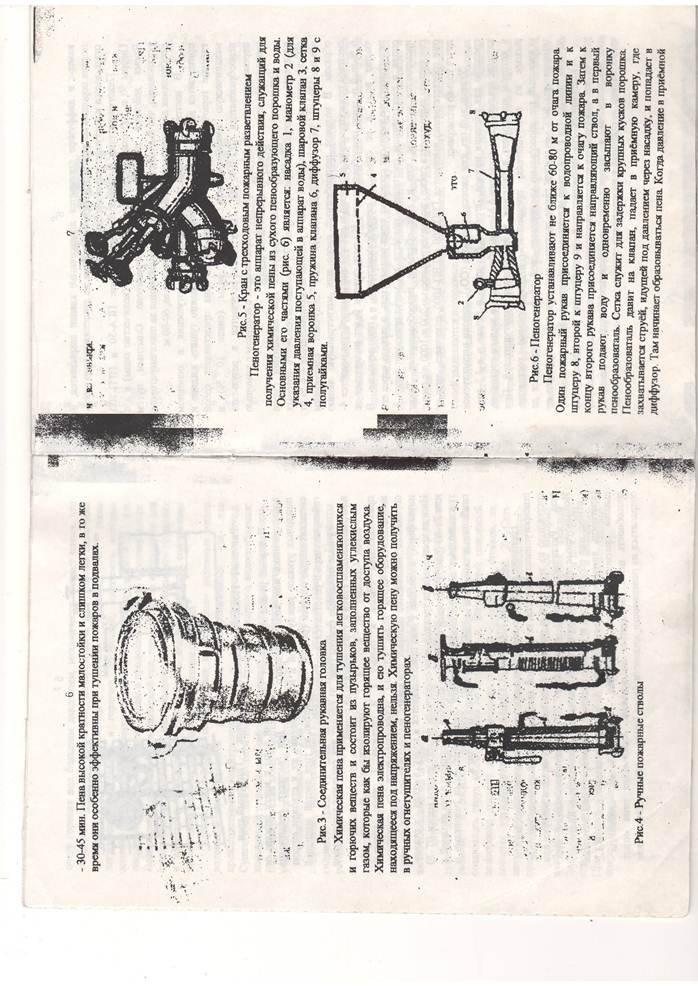
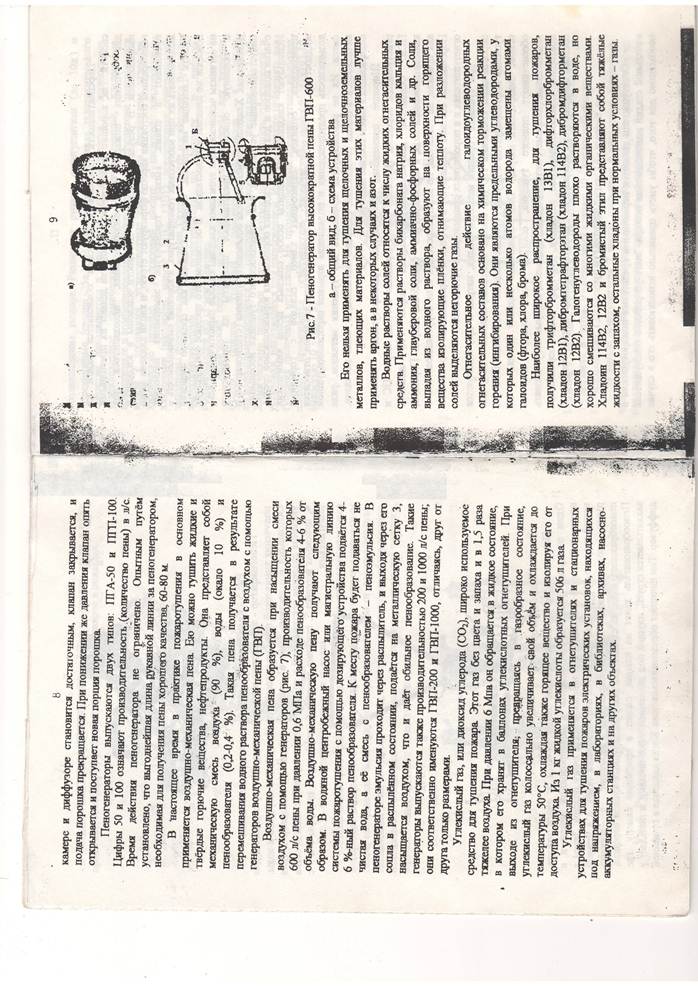
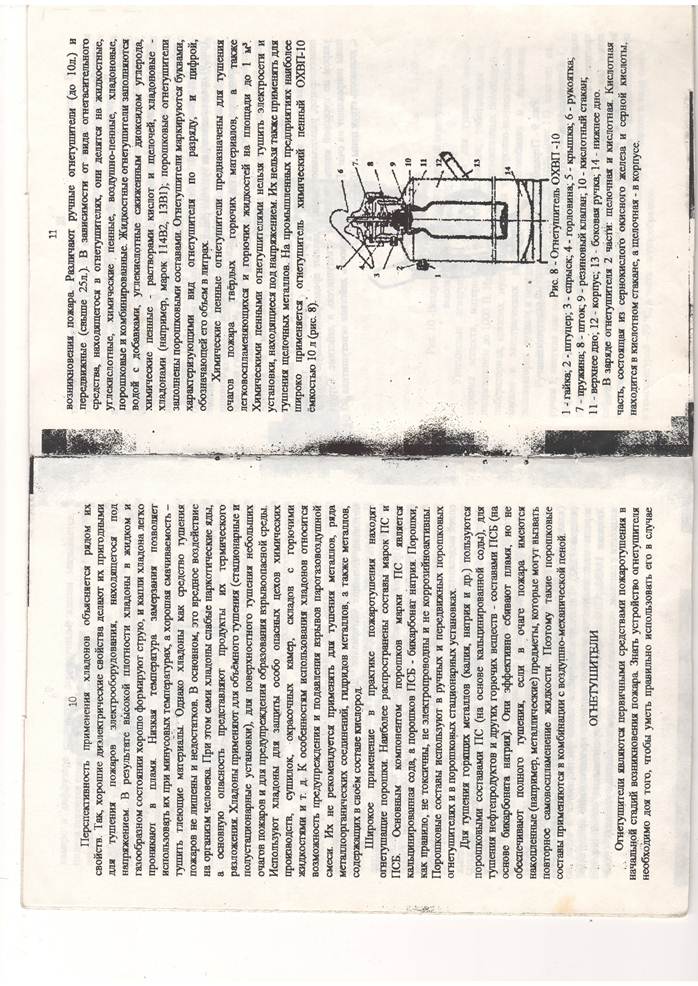
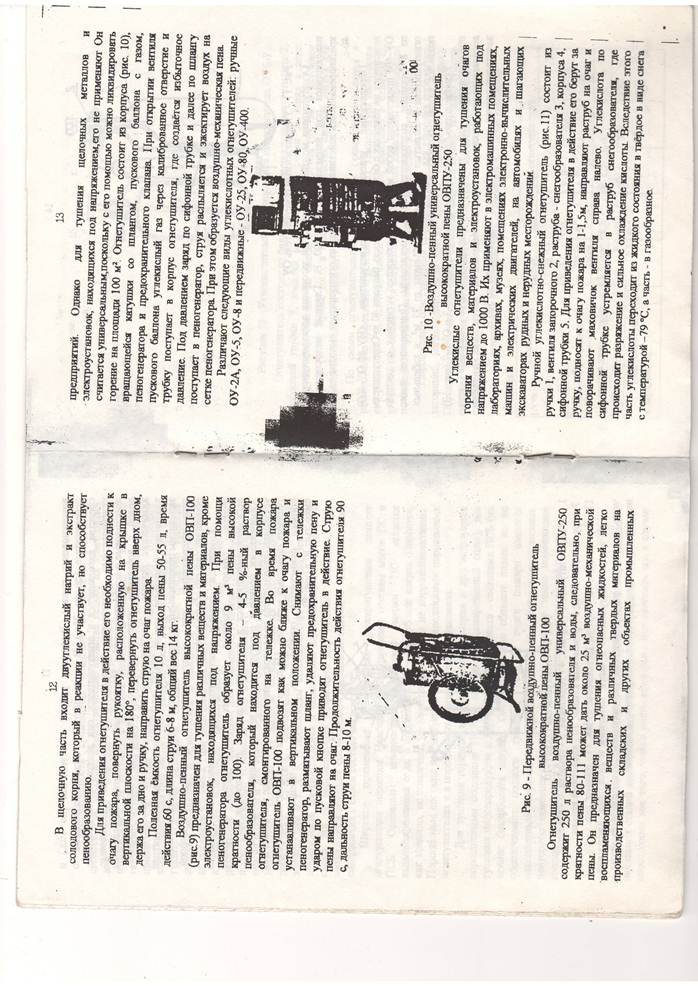
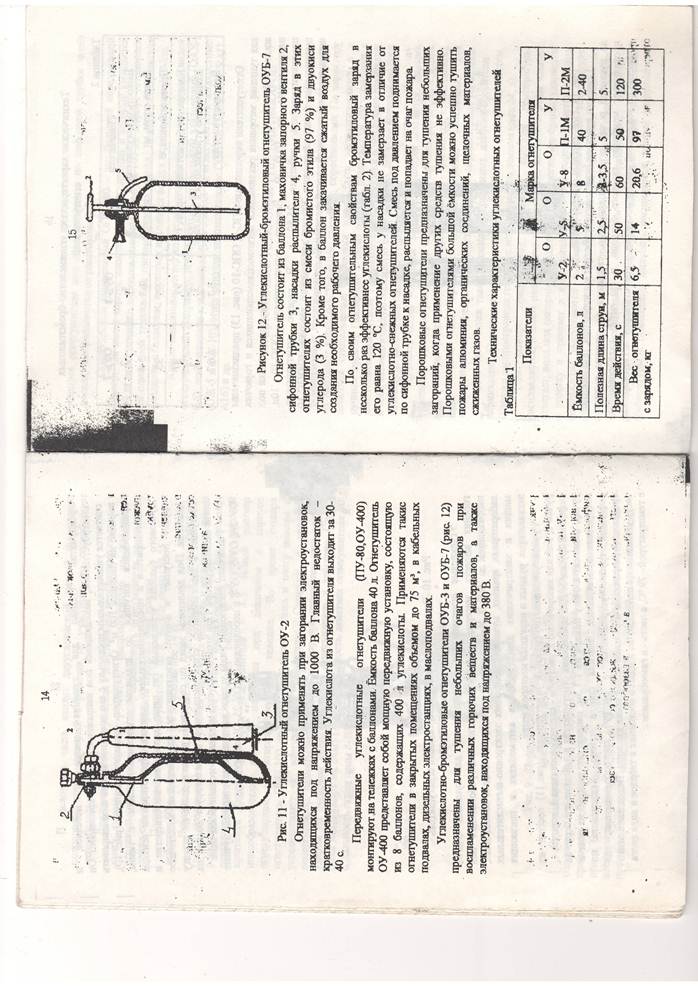
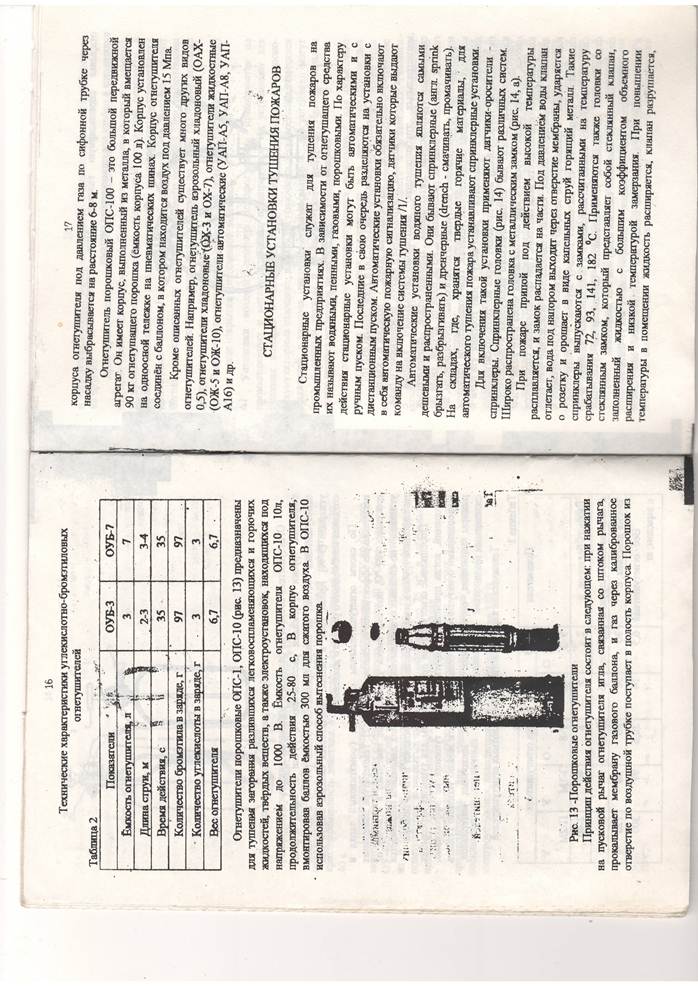
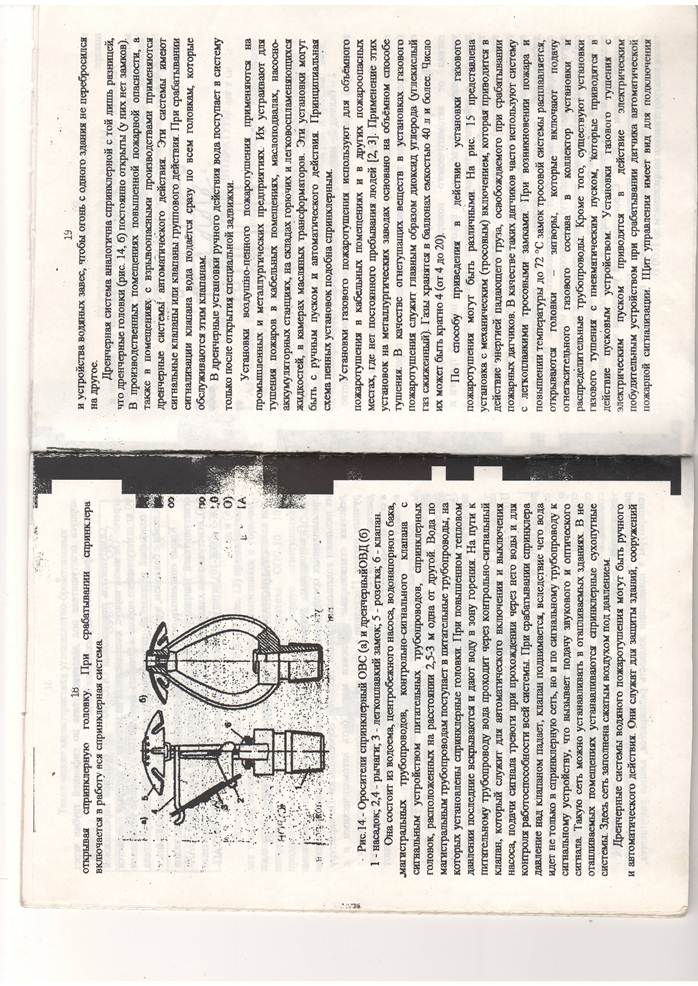
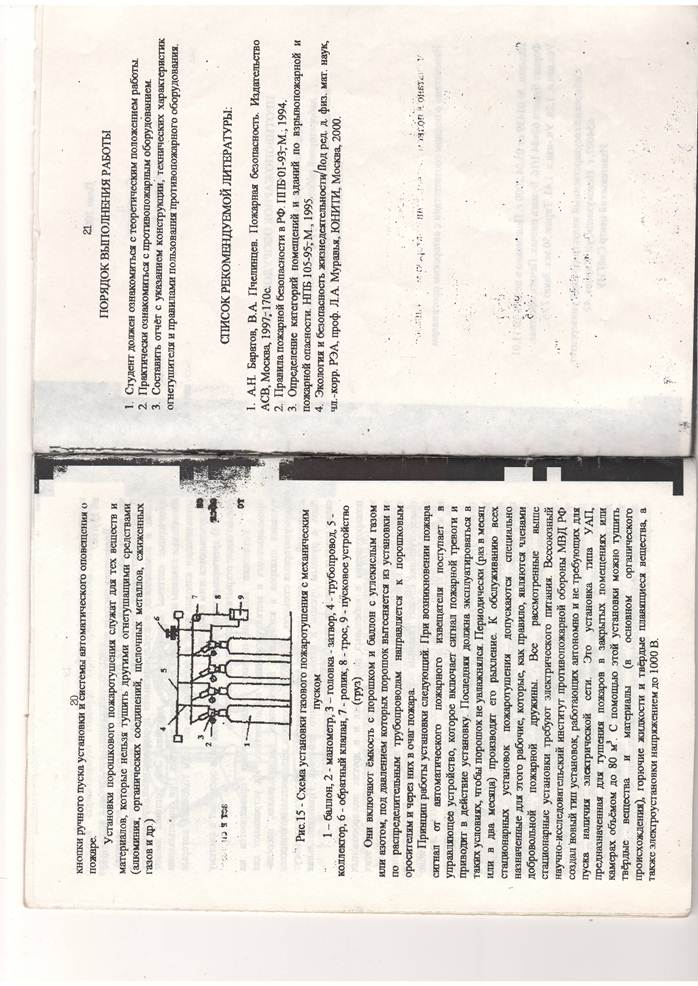
A fire extinguisher is the primary equipment that is used in case of detection of a source of fire and allows it to be completely or partially eliminated before arrival. fire service. That is why these devices, according to safety regulations, should be in every home, office, enterprise, and even in a car. What types of fire extinguishers can be found today?
General information
A fire extinguisher is a stationary or mobile type of device designed to extinguish small spontaneous fires. All these devices work on the principle of injecting their contents onto a hearth or object engulfed in flames.
Most often they look like a special red balloon equipped with a special nozzle or tube. And the substance contained inside it is under pressure and, if necessary, is brought to the surface by pressing the appropriate lever.
Fire extinguishers: types and characteristics
Depending on their intended purpose and the intended class of fire, all fire extinguishers can be conditionally divided into five types:
- liquid;
- powder;
- gas or carbon dioxide;
- air foam;
- air-emulsion.
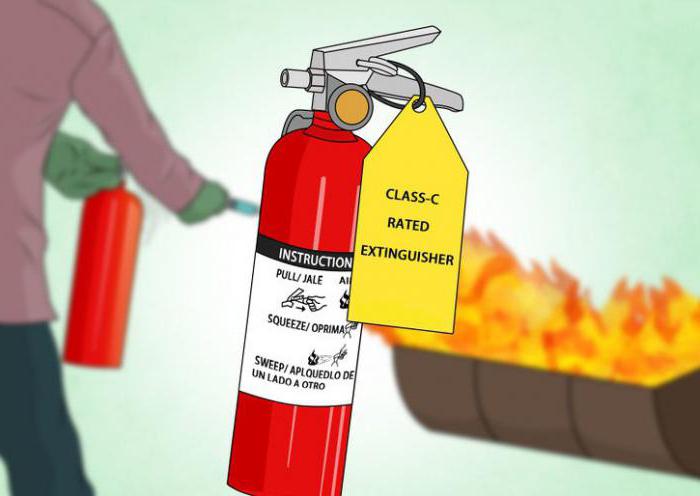
What fire extinguishers are called liquid?
Liquid, or water types of fire extinguishers are fire fighting equipment, designed to extinguish fires of class A (ignition of solid substances) and B (combustion of liquid substances).
They have the form of cylinders marked "S" and contain water or a solution on water based containing chemically active substances. It is noteworthy that such devices are not suitable for extinguishing other classes of fire. But on the other hand, it is liquid devices that, due to the presence of natural components in their composition, are considered the safest for health.
What are powder fire extinguishers?
Powder devices are universal types used fire extinguishers that can be safely used to extinguish almost all classes of fires: A, B, C (ignition of gaseous substances) and E (burning of electrical appliances and other objects under the influence of electricity). They have the established marking "OP" (devices of general purpose or use).
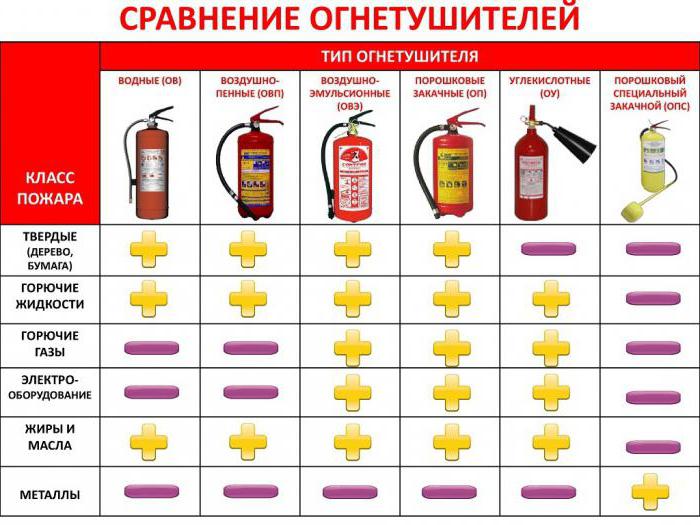
The composition of such fire extinguishers includes substances that have a powder base, as well as mineral salts and other components that allow you to keep the device in its original state. In other words, they save the powder from moisture and do not prevent the formation of lumps in it.
What subtypes of devices are powder fire extinguishers?
Powder fire extinguishers (purpose, types, application of these devices are listed in this article) are conventionally divided into separate groups:
- pumping;
- gas generating;
- self-triggering.
The composition of injection devices, as a rule, includes two components: a fire extinguishing powder and an inert gas (for example, nitrogen or carbon dioxide can act as its role). Sometimes, instead of inert gas, air is placed in cylinders under pressure of 15-16 atm. With the help of such a device, it is possible to extinguish fires of classes from A to E.
In addition, there is an internal pressure indicator on the head of the injection fire extinguishers, which clearly demonstrates their performance. If everything is in order with the equipment, the indicator scale will turn green.
Gas generating - fire extinguishers operating on the principle of using energy, the generation of which occurs during the extinguishing of a fire (at this moment, gas escapes and the extinguishing agent itself is released). Such devices have general principle start, except for the necessary waiting period (is 6-10 seconds). Here are the types (fire extinguishers of this type can be seen in the photo below) belong to gas appliances.
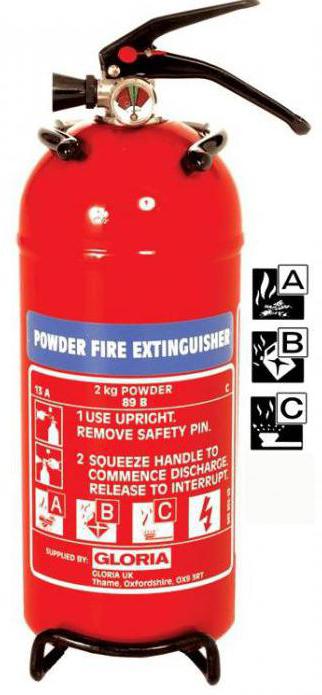
There are also self-acting fire extinguishers. As their name implies, such devices can work without the direct participation of a person. Most often they are part of the fire extinguishing system and are able to work only at a certain temperature. It is these devices that are usually installed in offices, warehouses, garages and domestic premises.
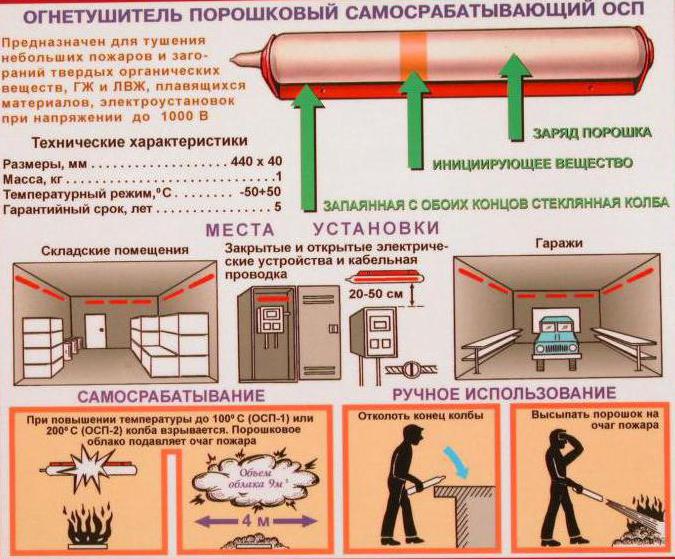
What are gas fire extinguishers?
Gas or carbon dioxide devices are a large group of devices that have one common “OU” marking. It includes the following types of fire extinguishers:
- aerosol;
- carbon dioxide-bromoethyl.
Many years ago, the same group included dangerous tetrachloric fire extinguishers, known for their negative effect on the human body. The fact is that during the extinguishing of a fire with the help of such equipment, chemical reaction: breathable gas was released. Therefore, it was possible to use the equipment only by wearing a gas mask, which caused extreme inconvenience.
Later, safer carbon dioxide types of fire extinguishers containing carbon dioxide began to be produced. Moreover, such devices have acquired both mobile and manual view. Such equipment, as practice shows, is used to extinguish fires of classes B and C. Most often they are used where it is impossible to get rid of the flame with water or powder.
The composition of aerosol and carbon dioxide-bromoethyl fire extinguishers includes the so-called halogenated hydrocarbons. When they are used, a lot of oxygen accumulates in the source of ignition (up to 18%), only at such a concentration of gas does the fire extinguish.
Where should gas fire extinguishers not be used?
However, it is not possible to use everywhere gas species fire extinguishers, and their use directly depends on the combustion process. In particular, flames must not be extinguished on objects made of, for example, aluminium, magnesium or sodium. The fact is that such substances can burn without access to oxygen, so gas devices simply will not work on them.
With their help, it is also impossible to extinguish the pipeline, or equipment with high operating temperature. This is due to the cooling effect that is observed when using reactive carbon dioxide. Otherwise, a sharp drop temperature regime may lead to subsequent depressurization.
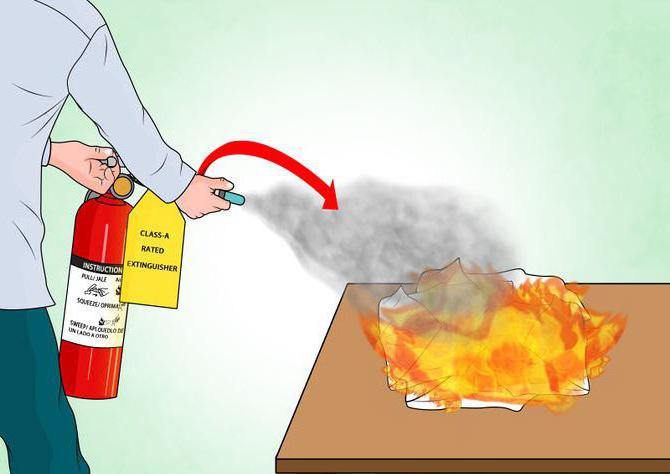
What are foam fire extinguishers used for?
Air-foam fire extinguishers are devices that are used to suppress fires in materials that are prone to prolonged smoldering, such as paper, coal, wood and plastic. In addition, with the help of such fire extinguishers, it is possible to extinguish the flame that has arisen on liquids having oil base, for example, oil, oils and paints.
However, air-foam equipment cannot be used to extinguish buildings and structures made of aluminum, sodium, magnesium, potassium and other alkaline earth metals. They are also not suitable for extinguishing flames in electrical installations that are connected to electricity.
Thanks to water-foam fire extinguishers, it is possible to quickly localize the source of fire due to the foam cover released from them, blocking the access of oxygen to the burning object.
What are air emulsion fire extinguishers?
Air-emulsion fire extinguishers are devices designed to extinguish fires of classes A, B and E. Their principle of operation is based on the energy of compressed air, used when applying a fire extinguishing emulsion to a flame.
With the help of such fire extinguishers, fires associated with gaseous substances (propane, ammonia, household gas), alkaline earth metals and the combustion of cotton and pyroxylin cannot be extinguished.
We examined what types of fire extinguishers are and the purpose of each type.
- manual or stationary device for fire fighting. A hand held fire extinguisher is usually a red cylindrical canister with a nozzle or tube. When the fire extinguisher is activated from its nozzle under great pressure a substance that can extinguish the fire begins to come out. Such a substance can be foam, water, any chemical compound in the form of a powder, as well as carbon dioxide, nitrogen and other chemically inert gases. Fire extinguishers in Russia must be in all industrial premises, and the rules traffic Many countries require a fire extinguisher to be kept in every car.Fire extinguishers are distinguished by the method of operation:
automatic (self-actuating) - usually permanently mounted in places possible occurrence fire;
manual (operated by a person) - are located on specially designed stands.
Fire extinguishers differ according to the principle of operation:
Designed to extinguish fires with fire-extinguishing foams: chemical or air-mechanical. Chemical foam is obtained from aqueous solutions of acids and alkalis, air-mechanical foam is formed from aqueous solutions and foaming agents by working gas flows: air, nitrogen or carbon dioxide. Chemical foam consists of 80% carbon dioxide, 19.7% water and 0.3% foaming agent, air-mechanical foam is about 90% air, 9.8% water and 0.2% foaming agent.
Foam fire extinguishers are used to extinguish with foam the beginning fires of almost all solid substances, as well as combustible and some flammable liquids on an area of \u200b\u200bno more than 1 m². Extinguish fires with foam electrical installations and electrical networks that are energized, it is impossible, since it is a conductor of electric current. In addition, foam fire extinguishers cannot be used when extinguishing sodium and potassium alkali metals, because they, interacting with water in the foam, release hydrogen, which enhances combustion, as well as when extinguishing alcohols, since they absorb water, dissolving in it, and when hit on them, the foam quickly collapses. Modern foam fire extinguishers use sodium azide as a gas-forming agent, which easily decomposes with the release of a large number nitrogen.
The disadvantages of foam fire extinguishers include a narrow temperature range of use (5-45 ° C), high corrosiveness of the charge, the possibility of damage to the extinguishing object, and the need for annual recharging.
These include carbon dioxide, in which liquefied carbon dioxide (carbon dioxide) is used as a fire extinguishing agent, as well as aerosol and carbon dioxide-bromoethyl, in which halogenated hydrocarbons are used as a charge, when supplied to the combustion zone, extinguishing occurs at a relatively high concentration of oxygen. (14-18%).
Carbon dioxide fire extinguishers are available both manual and mobile. Hand-held fire extinguishers are identical in design and consist of a high-strength steel cylinder, into the neck of which a shut-off and trigger device of valve or pistol type is screwed, a siphon tube that serves to supply carbon dioxide from the cylinder to the lock-starter, and a snow blower bell. To activate the carbon dioxide fire extinguisher, it is necessary to direct the snow blower to the fire and unscrew the handwheel to failure or press the lever of the shut-off and starting device. During the transition of carbon dioxide from a liquid state to a gaseous state, its volume increases by 400-500 times, accompanied by a sharp cooling to a temperature of −72 ° C and partial crystallization; in order to avoid frostbite of the hands, do not touch the metal socket. The effect of flame extinguishing is achieved in two ways: by lowering the temperature of the source of ignition below the ignition point, and by displacing oxygen from the combustion zone with non-combustible carbon dioxide.
To extinguish small fires of flammable liquids, gases, electrical installations with voltage up to 1000 V, metals and their alloys, powder fire extinguishers are used. During use, the cover of the fire extinguisher is removed and the powder is manually sprayed through the grid onto the combustion source. The resulting stable powder cloud sequesters the oxygen in the air and inhibits combustion.
Self-acting powder fire extinguishers
Designed for extinguishing fires of solid and liquid substances, oil products, electrical equipment under voltage up to 5000 V without human intervention with fire extinguishing powders of the ABC type, in small storage, technological, household premises, garages, etc. without permanent stay of people in them. If necessary, they can be used instead of or together with portable ones.
Aerosol fire extinguishing modules
Aerosol fire extinguishing installations are volumetric means of fighting fire. They have the advantages of traditional extinguishing agents- gases (high penetrating power) and powders ( high efficiency quenching and ease of storage). At the same time, aerosols have a number of undeniable advantages. This is, first of all, the absence of toxic and environmentally hazardous excretion products that are formed during the use of reactive halocarbons. The obvious advantage of an aerosol in comparison with a conventional powder is its high penetrating power and the absence of rapid settling of a suspension. Currently, domestic enterprises produce several series of aerosol fire extinguishing installations. They all use the same principle of aerosol formation, based on the process of burning some solid chemical compositions. As a result, a jet of a hot mixture of gases and solid microparticles is formed, which, filling the volume, extinguish the flame. The high-temperature jet of the emitted substance presents a known danger to people and objects in the immediate vicinity of the installation. That is why one of the main indicators of the quality of the installation is low temperature jets. If necessary, they can be used instead of or together with portable ones.
Any economy suffers huge losses due to fires. Therefore, every enterprise without fail there are fire-fighting stands and all necessary inventory for fire fighting. It is necessary to be able to use these means in order to do without calling the Ministry of Emergency Situations and to reduce losses due to fire to a minimum. In particular, know how to use a fire extinguisher.
What are fire extinguishers
Depending on the type of fire, equipment using different substances is used to extinguish:
- carbon dioxide;
- foam;
- freon fire extinguishers (ozone-depleting);
- powder.
Industrial models can be combinations of all these types (air-foam fire extinguishers, air-emulsion fire extinguishers).
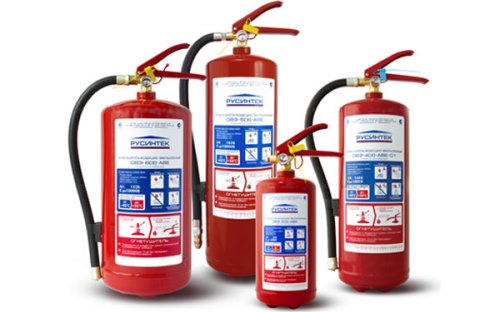
The marking of the fire extinguisher indicates its type, as well as the types of fires for which the model is intended.
Water models are almost universal, fires have been put out with water for centuries. Limitations are ignition of electrical wiring, electrical equipment and certain chemicals (magnesium, calcium carbide, aluminum powder).
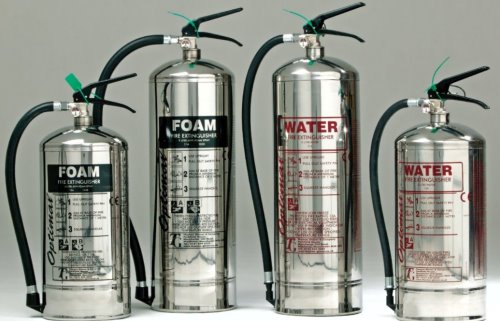
Fire extinguishers for extinguishing electrical installations - carbon dioxide. Their use has its own danger: cooling of metal parts and sockets to minus 70 degrees, due to which you can get frostbite on your hands. Work with this type of fire extinguishers should be in special gloves.
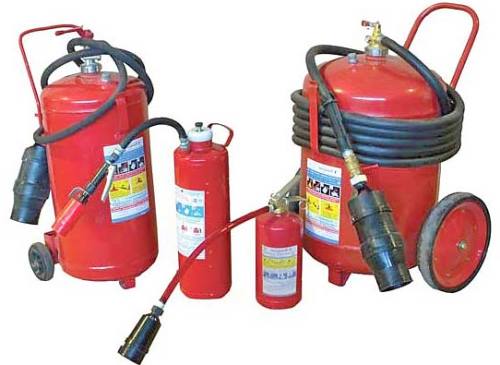
Before extinguishing the electrical wiring, it is necessary to turn off the electricity to the room. Extinguishing a fire with the electricity on is permissible only if it is not possible to de-energize the network.
Measures should also be taken when using powder fire extinguishers. personal protection: respirator, goggles. Getting into the respiratory tract and mucous membranes, the powder can cause serious irritation and allergic reactions. The use of powder fire extinguishers - to extinguish electrical fires after a power outage.
Video "Types and how to use a fire extinguisher":
When using a pumped fire extinguisher, pay attention to the position of the pressure gauge needle. It must be located in the green zone, otherwise the fire extinguisher cannot be used (overpressure or underpressure).
Procedure
Regardless of the type, how to use a fire extinguisher, the principle is very similar:
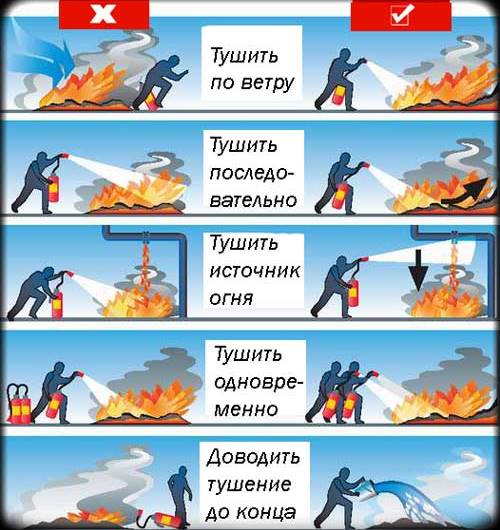
1. Deliver to the fire site.
2. Wear personal protective equipment.
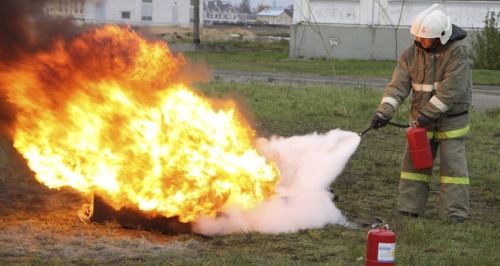
4. Remove the seal.
5. Pull out the pin.
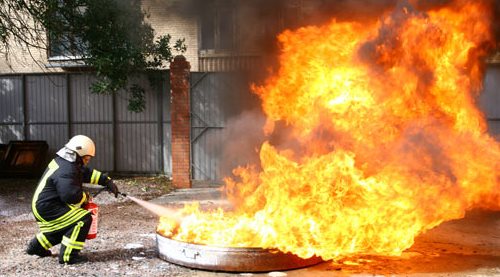
6. Press the button. When using gas generating and cylinder models (indicated on the label), wait a few seconds (depending on the specific model) to reach the operating pressure level. This rule does not apply to other models.
Video "How to use a carbon dioxide fire extinguisher":
7. Spray fire extinguishing medium.
Technology how to use a fire extinguisher in case of extinguishing burning wood with a powder fire extinguisher, after the flame has disappeared, it is necessary to spill the surface with water to prevent re-ignition.
→ Indoor safety rules →
According to the rules fire safety each enterprise must be equipped with the necessary number of fire extinguishers. Fire extinguishers differ in the type of fire extinguishing agents, in the way they are supplied, in the type of start-up devices and in the volume of the case. It is especially important to know about the fire extinguishers of log house owners.
The main classifications of fire extinguishers
One of the main features of fire extinguishers is the volume of the body; fire extinguishers are distinguished on this basis:
Manual small-capacity (up to 5 l) and industrial (5-10 l);
Mobile and stationary (over 10 l).
Starting devices in fire extinguishers are different, this feature determines the following types of fire extinguishers:
With gate valve;
With a pistol-type shutter;
With squib;
With starting device dependent on a constant pressure source.
Fire extinguishers also differ in the way the content is supplied, the release of the fire extinguishing agent can be carried out:
Under the pressure of gases that are formed chemically after the components that make up the charge react;
Under the pressure of gases contained in the fire extinguisher body;
Under the pressure of gases, the supply of which is made from a special cartridge located directly in the fire extinguisher body;
Under own pressure of the internal environment of the fire extinguisher.
Classification of fire extinguishers depending on the type of fire extinguishing agent
Depending on the type of fire extinguishing agents, there are six types of fire extinguishers.
1. Powder fire extinguishers. They come with powders for general and special purposes. The former are used in the elimination of fires of materials containing carbon (wood, gases), the latter - in extinguishing fires caused by the combustion of alkali metals, pyrophoric substances or aluminum compounds.
2. Carbon dioxide fire extinguishers. Liquefied carbon dioxide acts as a fire extinguishing agent. When igniting electrical installations under voltage and substances that do not support combustion without oxygen, hand-held carbon dioxide fire extinguishers can be used. When extinguishing fires in rooms where the use of water is undesirable (archives, museums, etc.), it is recommended to use mobile carbon dioxide fire extinguishers. Also, their use is shown in the combustion of flammable liquids, if the ignition area is not more than 5 m 2, internal combustion engines.
3. Liquid fire extinguishers. The extinguishing agent in this case is pure water, an aqueous solution of certain chemicals, or water to which surfactants have been added. It is possible to use these fire extinguishers only at positive temperatures.
4. Foam fire extinguishers. They have a wide range of applications, with the exception of cases where the foam can serve as a conductor of electric current. Foam, which is a fire extinguishing agent in fire extinguishers of this type, is formed from aqueous solutions of alkalis and acids.
5. Air-foam fire extinguishers. They are used to extinguish medium category fires. Do not use these fire extinguishers in case of ignition of alkali metals, substances that support combustion without oxygen, electrical installations under voltage. The fire extinguishing agent is an aqueous solution of the PO-1 foaming agent; abroad, instead of PO-1, the “light water” wetting agent is used.
6. Aerosol fire extinguishers. Halogenated hydrocarbons that promote vaporization, for example, ethyl bromide, freon, act as a fire extinguishing agent. These fire extinguishers cope well with fires in electrical installations, flammable liquids, various solids, with the exception of alkalis and substances containing oxygen.

